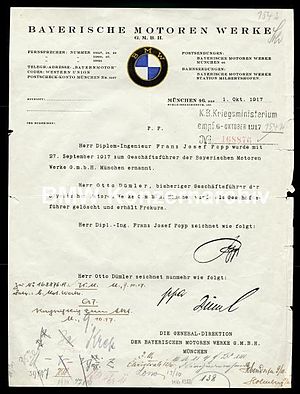BMW’s first aircraft engine, the 111A won much praise upon its release due to a unique high altitude carburettor which its competitors simply couldn’t touch. This led to the government making large orders which kept BMW busy until the end of World War 1.
The armistice forced BMW to cease production of military equipment leading them to expand into boat and truck engines, farming equipment and perhaps most significantly in the 1920’s, motorcycle production. The early 1920’s also saw the first use of the BMW logo still used today. It is commonly believed to represent a white aircraft propeller against a blue sky although sources at BMW are rumoured to dispute this, claiming it is simply representative of the flag of the Free State of Bavaria.
1928 sees BMW purchase a factory and with it the rights to produce their first car, the Dixi 3/15, essentially an Austin 7 built under licence. It sported a 743cc engine producing 15hp which could achieve 50mph. Car production advanced throughout the 1930’s with features introduced such as the in line 6-cylinder engine and twin kidney shaped radiator grills, both characteristics which commonly feature on BMW’s today.
All production of cars halted with the commencement of World War 2 as The Armistice was ignored and BMW’s factories resumed production of military equipment including motorcycles, jet engines and rocket engines. The war resulted in most of BMW’s factories being destroyed, leaving Munich which was dismantled and Allach which was allowed to carry out repairs on US motorcycles.
The 1950’s sees the Allied 250cc engine limit lifted and motorcycle production progress with great success. Car production resumes initially with the ill judged 501 Sedan built in the Munich factory. Its V8 power plant and luxurious nature are deemed irrelevant in tough economic times and sales are very slow. At the other end of the scale, BWW obtain the rights from ISO in Italy to produce the Isetta. This two seat microcar used a motorcycle engine and could even be driven on a motorcycle licence. This was far more appropriate for the time and BMW sold over 160,000 in the 1950’s. Even this wasn’t enough to keep BMW profitable though and by 1959, new majority shareholder Herbert Quandt set up the sale of the company to Daimler-Benz, only to be persuaded to pull out at the last minute.
The 1960’s and 70’s saw the introduction of many new BMW models including sporty two seater roadsters and cars such as the 3, 5, 6 and 7 series, all still produced today. We also see the introduction of BMW Motorsport with the homologation special M1. Modern day BMW Motorsport M models are instantly recognisable with their red, blue and purple badges.
In 1994 BMW acquired the Rover Group which also included MG, Mini and Land Rover as well as defunct brands, Austin, Morris, Riley, Triumph and Wolseley. This proved to be an economic disaster and the group were disbanded in 2000 with MG and Rover forming MG Rover group and Ford buying Land Rover. BMW kept the Mini brand as they had rather large plans for it which resulted in the hugely successful New Mini range being launched in 2001.

BMW India Private Limited (Photo credit: Wikipedia)
In recent years, BMW have temporarily owned a part of Roll Royce but this saw large scale legal wranglings and ended with Volkswagen taking control of Rolls Royce but BMW keeping the Bentley marque.
BMW are looked upon today as an innovative manufacturer of well built cars. This is due in part to the controversial flame surfacing introduced by then head of design- Chris Bangle. It’s also due to the expansion of the model range which includes some rather niche cars such as the X6, marketed by BMW as a Sports Activity Crossover Coupe!


